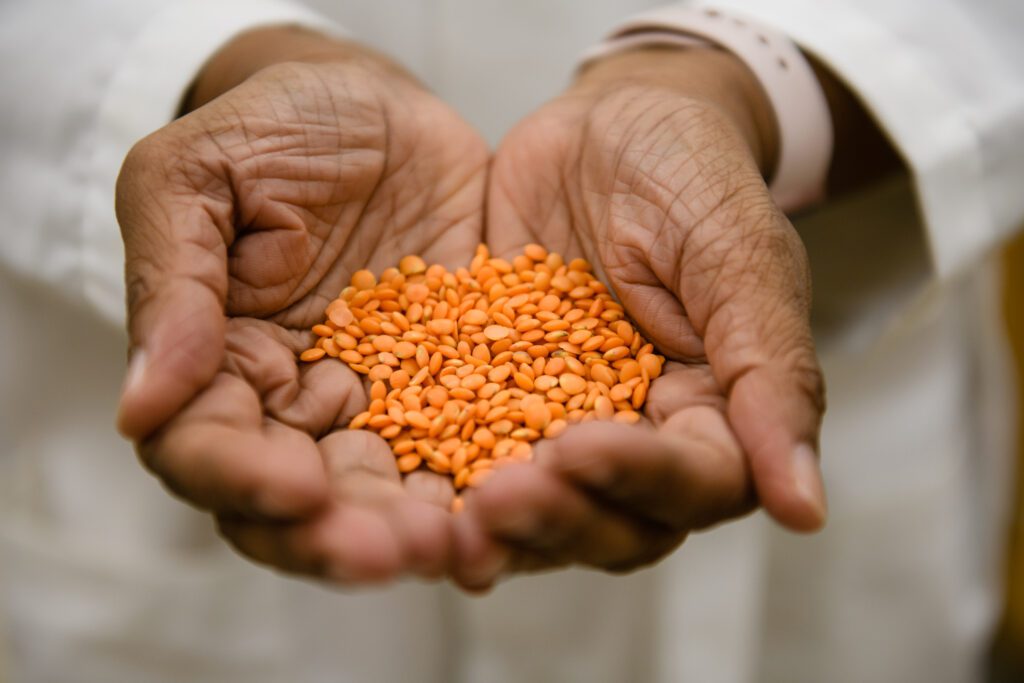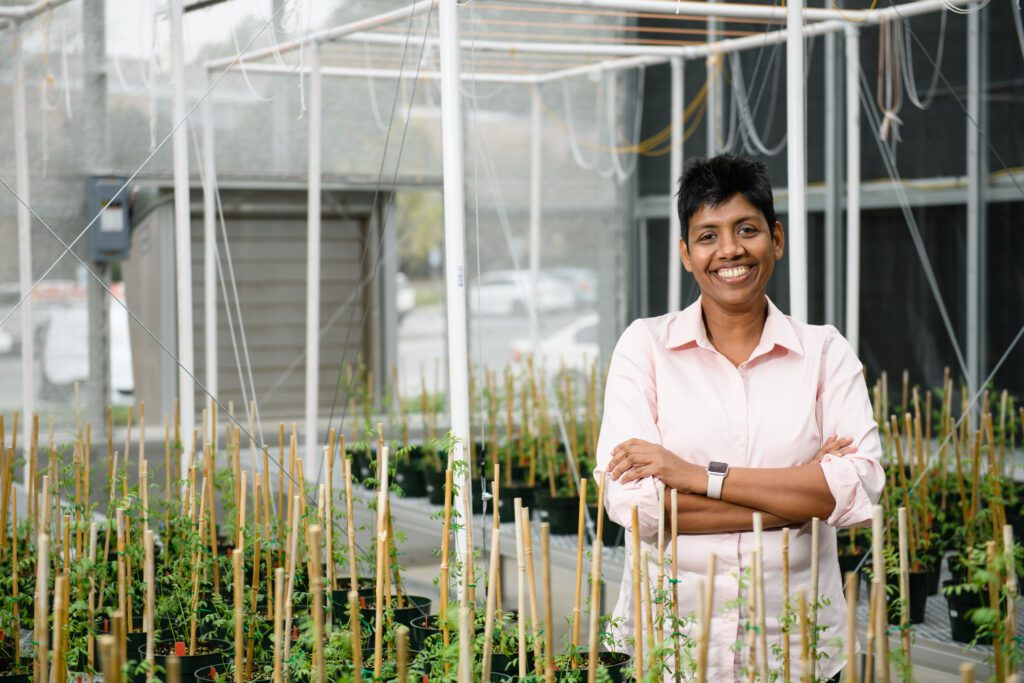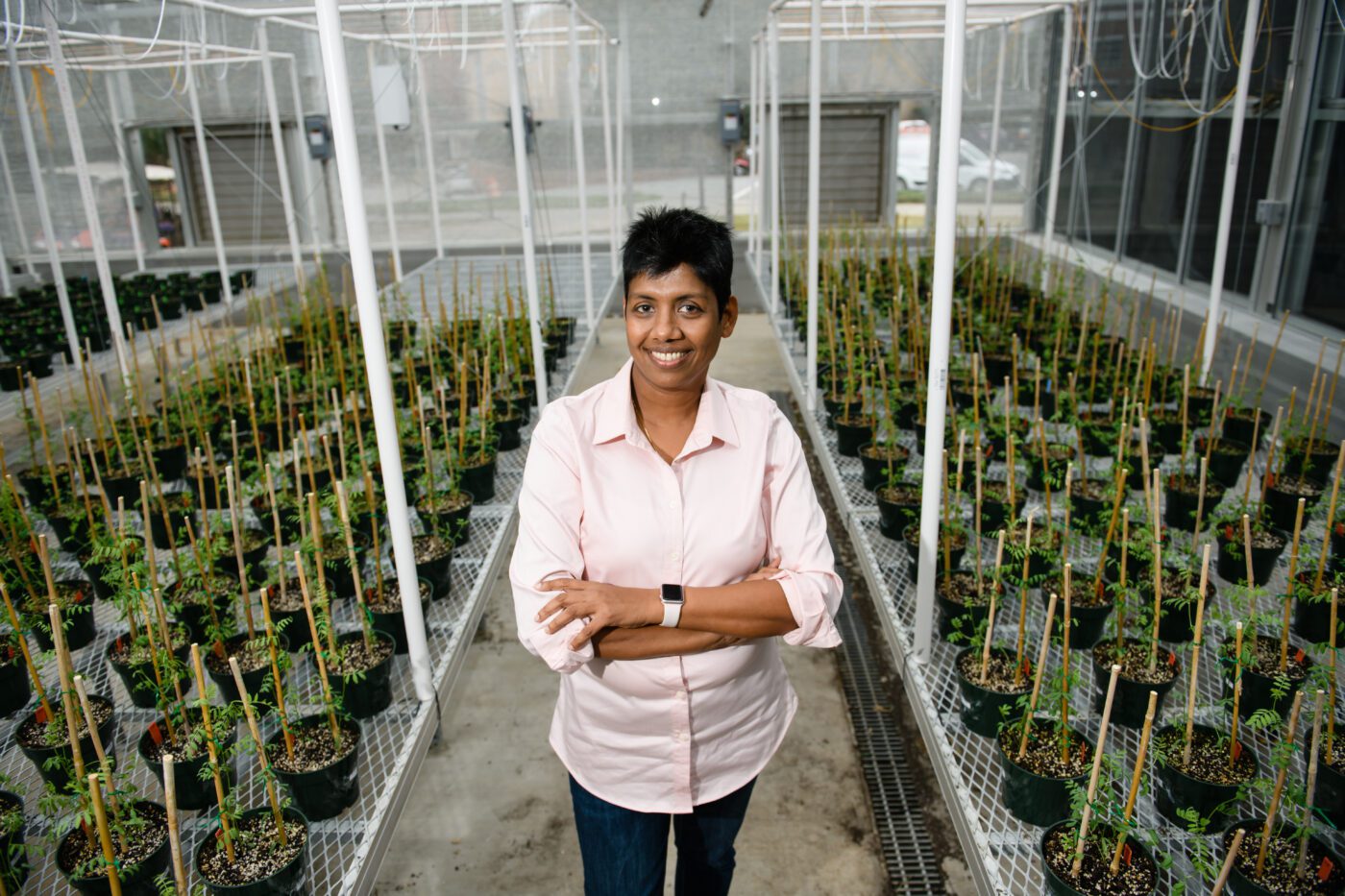Growing up in Sri Lanka, Dil Thavarajah learned of the nutritional value of pulse crops by eating them three times a day. Then, as a University of Saskatchewan graduate student in Canada, she studied how to grow pulse crops.
Today, she uses this experience and knowledge as a Clemson University researcher to benefit South Carolina growers and students.
A Jefferson Fellow and Clemson University professor, Thavarajah leads the Pulse Quality and Nutritional Breeding Program in the College of Agriculture, Forestry and Life Sciences. Her research — to develop nutritionally enriched, also known as “biofortified,” pulse crops — focuses on feeding and sustaining South Carolina communities and beyond.

She is exploring biofortified pulse crops (think: lentils, chickpeas and dry peas) that are rich in protein and essential nutrients and working to better understand how they benefit both consumers and the farmers who bring food to their dinner tables. And her findings are helping organic growers diversify their land with winter cash crops.
“Pulse crops aren’t just good for people; they’re good for the planet,” says Thavarajah.
What are pulses?
Pulses are the edible seeds of legume plants, harvested dry and used in dishes around the world. Everyday types include lentils, dry peas, chickpeas and common beans. Pulses are naturally rich in protein, prebiotics and micronutrients, low in fat, and affordable. More than just a superfood, pulses are also a regenerative crop. Their unique ability to “fix” atmospheric nitrogen improves soil health, reduces the need for synthetic nitrogen fertilizers and supports sustainable agriculture.
Lab to land: Making an impact for South Carolina farmers
The two principal growing regions for pulse crops in the U.S. have been the Northern Plains (Montana, North Dakota and South Dakota) and the Palouse (includes eastern Washington, northern Idaho and northeastern Oregon).
Thavarajah is working to make pulses a winter cash crop for South Carolina’s farmers.
She’s fulfilling a lifelong mission — deploying the power of food to strengthen communities — that’s now benefiting those living in South Carolina.

To help achieve success, Thavarajah’s research is funded by institutions such as the South Carolina Department of Agriculture, the United States Department of Agriculture National Institute of Food and Agriculture Organic Agriculture Research and Extension Initiative, USDA Agriculture Research Services, and Food Shot Global.
Her focus on organic pulse crops production uniquely benefits East Coast growers, but her findings have a national impact. By blending plant science with food systems innovation, her research has made Clemson one of the country’s leading publicly funded institutions in organic pulse breeding. Thavarajah’s breeding program focuses on on-farm research with South Carolina organic growers.
She recently received major USDA-NIFA grants to fund her research. Thavarajah and her team are working to grow opportunities in South Carolina by developing organic cultivars of chickpeas and dry peas that are specifically suited for Southeastern climates.
These crops, adapted to production in sandy coastal and clay-heavy soils, will be designed to thrive in winter, offering farmers a valuable USDA-certified organic option that requires no irrigation and no chemical inputs. Field trials are occurring across South Carolina in Clemson, Columbia, Pelion and Hardeeville.
“These are brand-new cash crops for the Southeast,” Thavarajah explains. “We’re creating profitable options for organic growers and building the infrastructure to support them from seed to harvest.”
“These are brand-new cash crops for the Southeast. We’re creating profitable options for organic growers and building the infrastructure to support them from seed to harvest.”
Dil Thavarajah
While the breeding pipeline focuses on South Carolina, scientists expect to expand future testing to other Southeastern states with similar climates. And the work is already reshaping crop rotation strategies, creating new market potential for the state’s agriculture-based economy.
Clemson’s pulse quality and nutritional breeding program
Housed within Clemson’s College of Agriculture, Forestry and Life Sciences, the Pulse Quality and Nutritional Breeding Program is just one of a growing group of signature initiatives focused on 21st-century competencies. The group consists of doctoral and undergraduate students, research scientists, and field and lab technicians.
Advanced Plant Technology and Precision Agriculture are additional programs that reflect Clemson’s land-grant mission to transform lives through science, innovation and education.

The Pulse Quality program develops short-season, high-protein legumes tailored for organic systems. Through collaborations with the USDA, local farmers and industry partners from South Carolina, including Anson Mills, WP Rawl and Rollen’s RAW Grains, the team is making strides in genomic prediction systems, sensory evaluations and on-farm breeding pipelines.
New dry pea cultivars, scheduled for release in 2026, have already demonstrated:
- Winter adaptation: planted in January, harvested in May
- Early maturity: 90- to 95-day growing cycle
- High yield: comparable to chemically supported crops
- Nutritional value: high in protein, sulfur-containing amino acids, resistant starch and total starch
- Organic breeding capability: developed through on-farm trials tailored to organic practices managed by farmers
- Disease tolerance: fungal and bacterial disease tolerance
Best of all, these efforts are backed by a strong partnership with agricultural experimental stations and Clemson Extension, which helps farmers implement this research in real-world, real-farm settings.
Cultivating curiosity with students
In addition to South Carolina’s growers, Clemson students are also key players in Thavarajah’s mission. To mark the 10th anniversary of Tiger Gardens, Clemson’s student-run educational garden, students compiled the “Tiger Gardens: Pulse Cookbook” in 2024 as a creative response to hidden hunger. The cookbook offers pulse-based recipes from around the world, along with preparation tips, nutrition facts and cost-per-serving insights. Featured dishes range from Sri Lankan Red Lentil Curry and Hazzardly Nutritious Pesto Pasta to Garbanzomole and Cherokee Bean Cakes.
Students in the Pulse Quality program prepared dishes from the cookbook, strengthening their understanding of the research, nutrition and real-world impact of the crops they study.
“It’s about helping people eat better, affordably,” said agribusiness major Dillan Hazzard ’24, who graduated shortly after the cookbook was completed. “The more people know about pulses, the more likely they are to use them.”
Working with a doctoral student in the Pulse Quality and Nutritional Breeding program, the pulse breeding research has even included opportunities for students to explore the taste, texture, smell and overall sensory experience of eating South Carolina-grown organic pulses. The Sensory Evaluation Study, funded by NIFA, provides valuable insights into the sensory attributes and consumer perception of pulse crops. Findings will contribute directly to the ongoing advancement of Clemson’s breeding program as they develop new cultivars that have high consumer acceptance.
Through coursework, fieldwork and community engagement, these students are gaining the tools to grow pulses and their economic footprint on South Carolina.
The Clemson difference
Thavarajah’s work reflects the very heart of Clemson’s mission: growing knowledge and supporting agricultural communities by pursuing sustainable farming practices.
“Being part of this Clemson Family of experts, I know we can make a difference,” she says.
With every seed sown, student mentored and recipe inspired, her work and her research move Clemson and South Carolina Fiercely Forward.








